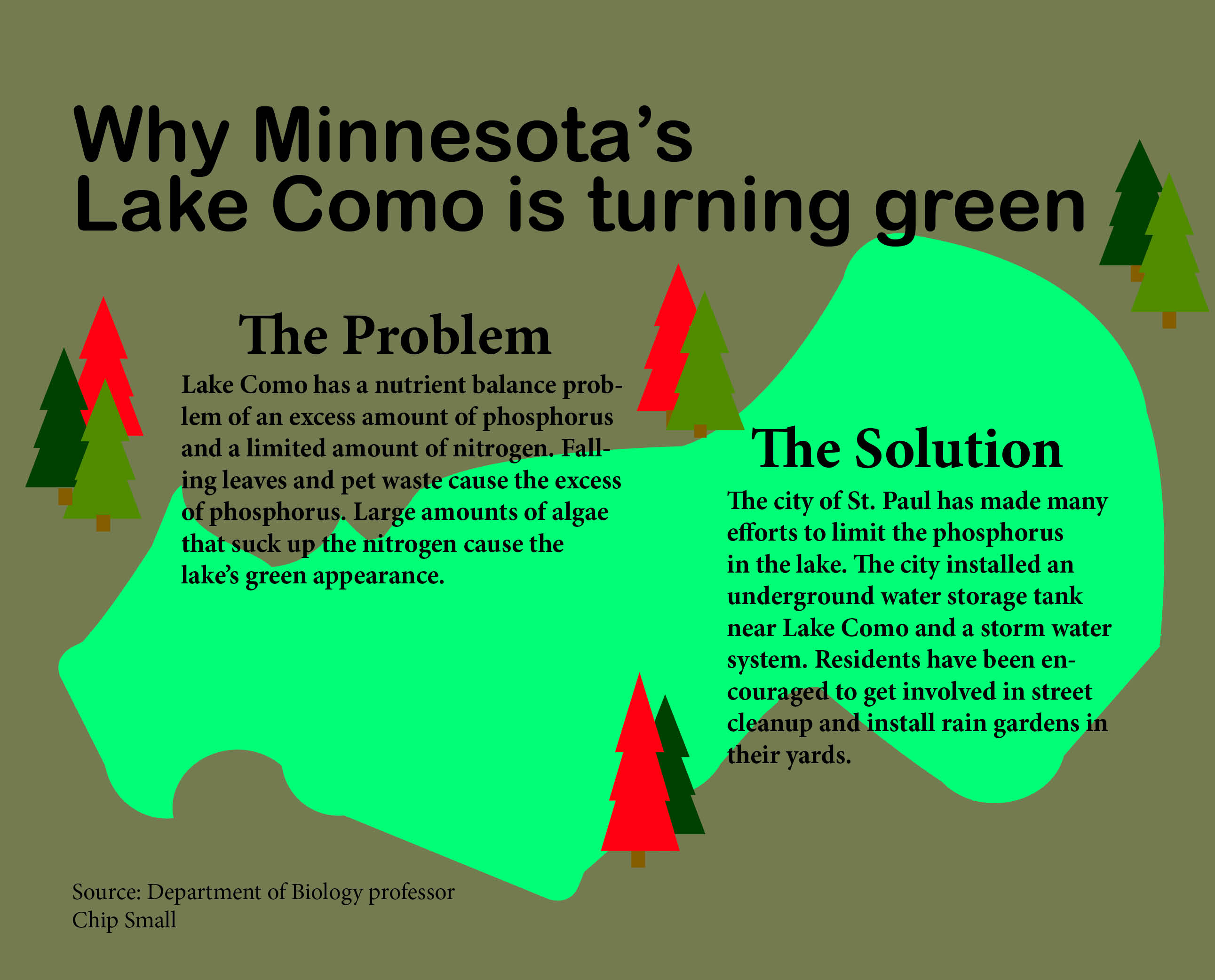
Professor Gaston “Chip” Small and St. Thomas biology students recently received a grant from the Environmental Protection Agency to conduct research on a nutrient imbalance problem in St. Paul’s Lake Como.
The $15,000 grant given this summer allowed Small and his students to analyze the lake, which has an excess amount of phosphorus stored in the lake’s sediment. At the same time, algae is soaking up nitrogen, which causes a nitrogen deficiency in the lake. Much of the excess phosphorus comes from falling leaves and pet waste, Small said.
“Any urban or agricultural areas tend to have lakes that have excessive amounts of nutrients,” Small said.
Senior Louis Sand initially started working with Small on the project two years ago. He collected water from Lake Como, grew plants in the water and gathered measurements on their growth and nutrient intake.
Junior Jessica Brown began working on a separate facet of the project, which involved finding out what specific nutrients were being limited in the lake. Her part of the project focused on how plants had an impact on the water.
This past summer, junior Quinn Niederluecke began measuring phosphorus in the lake’s sediment. Her portion of the project involves computer work, which she is continuing this semester.
“I’m working on getting a model of Lake Como up and running on the computer, which can show how nutrients flow in and out of Lake Como and potentially try out different solutions to the problem that they are having with the excess nutrients of algae,” Niederluecke said.
Small heard about the grant from colleagues, and he, along with other members of the biology department, considered various ideas to submit to the EPA. Small decided to submit the Lake Como project plans that were based on Sand’s prior study.
The department was given the EPA’s People, Planet and Prosperity Award, which grants $15,000 to students to conduct environmental research. The university has been approved for Phase I of the award. In this stage, the team is expected to research an issue’s challenges and seek potential sustainable solutions. Forty-two awards were given across the country.
Based on the findings, the EPA may grant Small the Phase II award, which is designed to implement the potential sustainable solutions. It could fund up to $75,000 and is given out to fewer Phase I winners. Students will attend a conference in Washington, D.C., in April during which their reports, proposals and presentations will be scored. The exact number of winners is not predetermined but is based on the quality of the projects.
Small’s project to repair Lake Como is one of many. St. Paul has made multiple efforts to limit the amount of phosphorus going into the lake. The Capitol Region Watershed District has been collecting data and its improvement efforts include the installation of an underground water storage tank and a stormwater system. Small said it also has encouraged residents to get involved in street cleanup and install rain gardens in their yards.
But he explained that the university has taken a different approach to the problem.
“All the projects have been focused on putting less in, which is important, but we have this data from the sediment that there’s so much in there already. Whatever nutrients come in, they just stay there and build up over time,” Small said.
One solution, according to Small, is to create a hydroponic garden with plants that soak up the excess nutrients, which Brown worked on.
“My project was focusing on how different plant types will react with the lake water, so we focused on nitrogen-rich plants because Lake Como is nitrogen-deficient,” Brown said. “Then we analyzed how much phosphorus they were able to take in.”
Along with doing research at the lake, the team has also used the aquaponic system at St. Thomas. They brought in fish and plants to attempt to create a design for what could be done to lakes based on this smaller scale. However, Small said there is a difficulty in finding balance.
“There’s this sort of paradox with trying to grow these plants. There are too many nutrients in the lake, and that’s why there is so much algae. At the same time, the plants you are growing would like even more nutrients in the water, and so it’s hard to keep them all happy,” Small said.
As for the future of the project, Small said his spring 2015 Environmental Problem Solving class will pick up where these students have left off by continuing to do experiments and sampling on the lake. Sand and Brown are not working on the project currently.
Niederluecke said she hopes the project can do even bigger things in the future.
“I see us looking at other lakes as well as Como to see and compare the differences in how the solution could be affecting the area or potentially how solutions can help out these urban lakes,” Niederluecke said.
Lauren Smith can be reached at smit7607@stthomas.edu.

